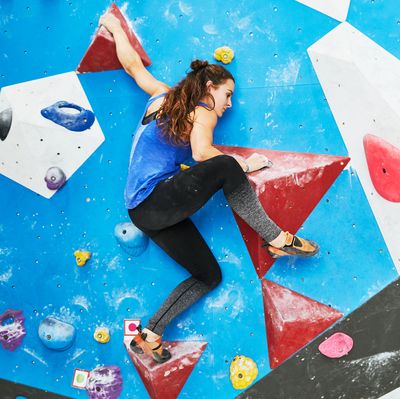
At some point in the last few months I put my head down, and when I lifted it, everyone I knew was “bouldering.” Zac Efron is doing it. Jared Leto is doing it. Jason Momoa does it. Brie Larson does it. And those are just my close friends. Last year, the Climbing Business Journal reported that 43 new commercial climbing gyms opened in the U.S. in 2017, a growth rate of 10 percent over 2016, compared to the 6 percent of the several years prior. That number brings the current U.S. climbing gym total to roughly 450. The numbers for 2018 have yet to be published, but climbing professionals, like Jennifer Tanaka, an instructor at Rockreation climbing center in Los Angeles, say the industry is “exploding on all ends.” But why?
“To be frank, I was bouldering with my friends in Central Park in 2003,” says Andrew Fanelli, the regional marketing manager for Brooklyn Boulders, New York City’s first dedicated climbing gym, which was established in 2009. “But I think because it’s a solo activity and easy to pick up, it’s having a moment.” While Fanelli says it’s company policy not to disclose membership numbers, he will say they’re “definitely increasing.” While membership costs vary (Brooklyn Boulders charges $135 a month), the sport has a relatively low barrier to entry in other respects. Unlike top-roping (the other main form of rock climbing) bouldering requires very little equipment, and no partner. Typically, you just need the shoes — and many gyms, including Brooklyn Boulders, rent them out, if you’re so inclined. (Heh.)
Though the Instagrams I’ve seen suggest otherwise, Fanelli, along with several other climbers I talked to, insist climbing doesn’t require immense, immediate physical strength, or a particular body frame. “Bouldering isn’t so dependent on strength or height,” says the novelist R.O. Kwon, author of The Incendiaries, who started climbing a couple of years ago. “Some of the best climbers are women. There’s something very fun about not feeling constrained, in any way that can’t be overcome, by my size and height.”
Climbers I spoke to also emphasized how little bouldering “feels” like exercise, while providing a “pretty decent workout,” per Kwon. There is also something magnetic about how much focus it requires. “I found that it was one of the only physical activities I’ve come across that, while I’m doing it, I can’t think about my writing,” says Kwon. “I can’t think about anything else. That’s what I love about it.”
Diana Tsui, the senior market editor at the Cut, echoes these sentiments. Bouldering isn’t as “punishing or miserable” as other forms of exercise, she says, but it also provides a welcome source of total concentration. “It’s mentally challenging, but in a good way,” she says. “It’s like problem solving — literally, they’re called problems — and you have to figure out what works for your height/skills. I’m not the strongest climber but I do feel very accomplished when I send a problem.”
This specialized lingo — “problem” for a particular route, “send” for complete, etc. — is attractive in its own right, providing boulderers with a sense of belonging (and maybe a little superiority). A friend of mine, Jess Harrelson, has been bouldering for years, and they’ve seen first hand how the bouldering lexicon has drawn people in. “I think to some people the language is appealing,” they say, comparing bouldering culture to surfing culture, in that respect. “It makes it seem kind of magical.”
Harrelson adds that the prep involved with bouldering lends an aura of extreme athleticism to the sport. “I think people LOVE the gear aspect of climbing, like the cute little climbing shoes and the chalk bags and the harness,” they say. “It makes you really feel like you’re going on an expedition, even if it’s just a few feet up a sweaty wall.” People who participate in extreme sports often describe the experience as spiritual, and “life-enhancing,” and especially in places where outdoor climbing (or other, riskier sports) aren’t easily accessible, bouldering might provide the average, secular urbanite with the next best thing.
This, too, is where the 2018’s Free Solo comes in. The documentary, which depicts Alex Honnold’s attempt to complete the first free solo climb of El Capitan at Yosemite National Park, was wildly well-received, and earned the best screen average of the year, raking in $300,804 from just four theaters on its opening weekend. It’s difficult to measure the exact impact of the movie on the indoor bouldering world, but Tsui says she’s sure it played a role in propelling an interest in the sport. “Free Solo really captured people’s attention,” she says. “That movie put the sport into mass pop culture.” (Zac Efron, for instance, referenced the title directly in his Instagram post.)
Harrelson, on the other hand, worries the movie might have scared some bouldering hopefuls off. “Perhaps it inspired people to climb, but I feel it kind of made climbing seem too intimidating,” they say. (For the unfamiliar, El Capitan is a 3,000-foot-tall granite wall, a climb that has killed more than 30 people, with equipment.) Obviously, the average bouldering experience is, well, a much simpler problem than El Capitan — which is not to say it’s not scary, but that, too, is part of it. “I’m afraid of heights, but I think that’s part of the fun and part of what keeps it so entertaining, are those giant rushes of adrenaline that come with the fear,” says Kwon.
Fanelli agrees. “We do warn people that climbing is inherently dangerous. And people gravitate toward that,” he says. “Climbing has that risk factor that gives you that natural high, but it’s not an overt, intense competition.”
It doesn’t hurt, either, that bouldering is very Instagrammable — the 2.7 million Instagram posts currently tagged #bouldering depict walls covered in bright, rainbow-colored lumps, and bodies which look inherently athletic, even virtuous, for attempting to navigate them. Kwon points out, though, that the many people you’ll see taking photos at the gym aren’t doing it just for the gram. “A lot of people do take pictures and videos of themselves climbing, and I sometimes do too, but more than anything, it’s really helpful to watch yourself, especially if there’s a route you can’t get,” she says. “It’s helpful to watch and see what you’re doing, and what you could be doing differently.”
Whether it’s Free Solo– or Zac Efron–inspired, or something else altogether, climbers agree that bouldering gym attendance is up. “Climbing gyms have felt a little more crowded recently,” says Kwon. Harrelson agrees, diplomatically. “I think it’s cool seeing people get interested in the sport, even if it makes my current climbing gym too crowded, which is sad,” they add.
But the influx of new faces isn’t all bad — several sources tell me that bouldering gyms are where the hot people are. “It’s honestly the best place for a single woman,” says Tsui. “You can meet someone SO easily. It’s a solitary sport that’s really social — I’ve made new friends at the gym, and everyone talks to each other. You cheer each other on through problems.” !! I might cry. I have to go boulder immediately.





